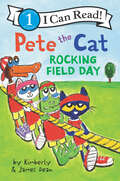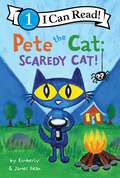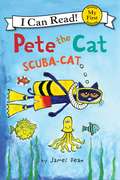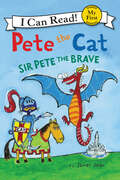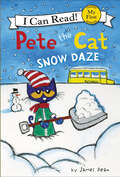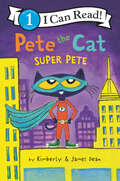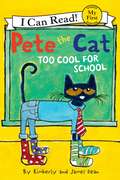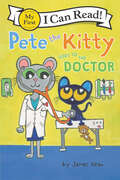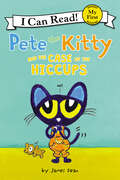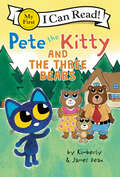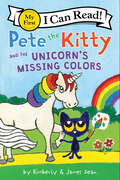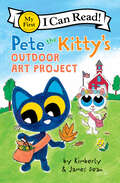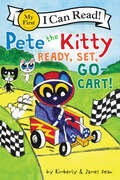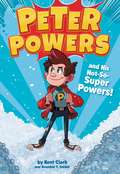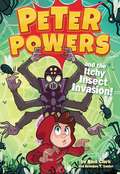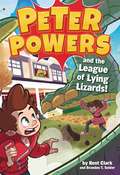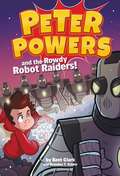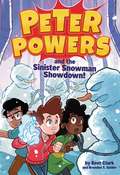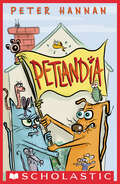- Table View
- List View
Pete the Cat: Rocking Field Day (I Can Read Level 1)
by Kimberly Dean James DeanFrom New York Times bestselling author-illustrator team Kimberly and James Dean comes a brand new I Can Read book in which Pete and his friends compete in Field Day!Ready, set, groove! It’s field day and Pete is excited for a day filled with fun activities, like the water-balloon toss, three-legged race, an obstacle course, and tug-of-war! Join Pete the Cat and his friends Callie, Grumpy Toad, and Gus as they compete for a medal on field day!Pete the Cat: Rocking Field Day is a Guided Reading Level J and a Level One I Can Read, which means it’s perfect for children learning to sound out words and sentences. Whether shared at home or in a classroom, the short sentences, familiar words, and simple concepts of Level One books support success for children eager to start reading on their own.
Pete the Cat: Scaredy Cat! (I Can Read Level 1)
by Kimberly Dean James DeanA scary story spooks Pete the Cat in this Level 1 I Can Read from New York Times bestselling creators Kimberly and James Dean.When Bob tells Pete the Cat a spooky, creepy, scary story about a monster, Pete is a little scared. The monster seems to be everywhere he looks! What will help Pete overcome his fear?Find out in this Level 1 I Can Read book complete with original illustrations from the creators of Pete the Cat, Kimberly and James Dean. Pete the Cat: Scaredy Cat! is perfect for children learning to sound out words and sentences. Whether shared at home or in a classroom, the short sentences, familiar words, and simple concepts of Level One books support success for children eager to start reading on their own.
Pete the Cat: Scuba-cat (My First I Can Read)
by Kimberly Dean James DeanNew York Times bestselling author and artist James Dean brings Pete the Cat’s world to life under the sea in this new I Can Read book.Pete the Cat is going scuba diving! Before he hits the water, Captain Joe tells him about all the sea creatures he can encounter, and Pete is super excited to see a seahorse. But when he is suited up and swimming around, he has to search high and low to find the little guy. In this aquatic adventure, Pete makes a new friend and gets a big surprise!Pete the Cat: Scuba-Cat is a My First I Can Read Book, which means it’s perfect for shared reading with a child. New readers will love the easy-to-read format and groovy illustrations in Pete the Cat’s first I Can Read underwater journey!
Pete the Cat: Sir Pete the Brave (My First I Can Read)
by Kimberly Dean James DeanNew York Times bestselling author and artist James Dean brings readers a new story about the most gallant cat around—Pete! This time Pete is a knight on an adventure to save a pal in Pete the Cat: Sir Pete the Brave.When Lady Callie, the most awesome harpist in all the land, goes missing, it’s up to Sir Pete to save her. But when he ends up trapped in a dragon’s lair, Lady Callie might have to do the saving.Pete the Cat: Sir Pete the Brave is a My First I Can Read book, which means it’s perfect for shared reading with a child.
Pete the Cat: Snow Daze (My First I Can Read)
by Kimberly Dean James DeanNew York Times bestselling author and artist James Dean brings readers along for a fun, surprising, snowy adventure with Pete the Cat! In Pete the Cat: Snow Daze, school is canceled, and Pete cannot wait to play in the snow with all his friends. Imagine a day filled with snowball fights, hot chocolate, snowcats, and more. But when the next day and the day after that are all snow days, Pete comes to a sudden realization—it is possible to have too many snow days.Pete the Cat: Snow Daze is a My First I Can Read book, which means it’s perfect for shared reading with a child.
Pete the Cat: Super Pete (I Can Read Level 1)
by Kimberly Dean James DeanFrom New York Times bestselling creators Kimberly and James Dean, Pete the Cat becomes...Super Pete! We all need a superhero Pete in our life.When there's trouble in town, it’s up to Pete the Cat's alter ego, Super Pete, to save the day! With his cool jet, nifty goggles, and slick slingshot, Super Pete is ready to take down any bad guys.Pete the Cat: Super Pete is a Level 1 I Can Read book, which means it's perfect for shared reading with a child and any heroes-in-training.
Pete the Cat: Too Cool for School (My First I Can Read)
by Kimberly Dean James DeanIf you want to be cool, just be YOU! That's the message of this funny, relatable Pete the Cat school story—and kids will laugh and agree.Pete the Cat can't decide what to wear to school in Pete the Cat: Too Cool for School. With so many groovy options to choose from, Pete just keeps adding on.All of Pete's friends have a suggestion for what he should wear to school. But by the time he's added cowboy boots, shorts with fish, his red shirt AND his yellow shirt—and even more—he's too hot.It's time to make his own clothing decisions and head back to school! You and your kids will giggle at Pete and his clothing choices, resolved with a positive empowering message.Pete the Cat: Too Cool for School is a My First I Can Read book. Each My First I Can Read book is carefully crafted using basic language, word repetition, sight words, and sweet illustrations—which means it's perfect for shared reading with emergent readers. The active, engaging My First I Can Read stories have appealing plots and lovable characters, encouraging children to continue their reading journey.
Pete the Kitty Goes to the Doctor (My First I Can Read)
by Kimberly Dean James DeanOh no! Pete the Kitty has a tummy ache. Good thing his dad knows just what to do. It’s time to go to the doctor!Except Pete may be a teensy-weensy bit nervous about his first visit to the doctor. With the help of his dad, Pete discovers the doctor isn’t scary.Beginning readers will easily relate to Pete the Kitty as he overcomes his fear of going to the doctor's office.This My First I Can Read book is carefully crafted using basic language, word repetition, sight words, and sweet illustrations—which means it's perfect for shared reading with emergent readers. The active, engaging My First I Can Read stories have appealing plots and lovable characters, encouraging children to continue their reading journey.From New York Times bestselling author/illustrator team Kimberly and James Dean, it's everyone’s favorite kitty, Pete the Kitty!
Pete the Kitty and the Case of the Hiccups (My First I Can Read)
by Kimberly Dean James DeanBeginning readers will laugh and easily relate to Pete the Kitty and his search for the perfect remedy for his hiccups!Pete gets a case of the hiccups, and he doesn’t know what to do. He decides to ask his wisest friends for help, like Grumpy Toad, Callie, and Bob. But Pete is still stuck with the hiccups. Will Pete the Kitty ever get rid of his terrible hiccups?This My First I Can Read book is carefully crafted using basic language, word repetition, sight words, and sweet illustrations—which means it's perfect for shared reading with emergent readers. The active, engaging My First I Can Read stories have appealing plots and lovable characters, encouraging children to continue their reading journey.This is the very first Pete the Kitty I Can Read favorite from New York Times bestselling Pete the Cat author-artist James Dean!
Pete the Kitty and the Mermaid's Sandcastle (My First I Can Read)
by Kimberly Dean James DeanA magical mermaid adventure from New York Times bestselling creators Kimberly and James Dean!Pete the Kitty and his mermaid friend Jessie work together to build a sandcastle. But the castle is missing something. Will one shell, two barnacles, three strands of seaweed, and more gifts from the sea be enough to make their sandcastle the best it can be?Young mermaid fans and beachgoers will love building and counting with Pete and Jessie in this My First I Can Read story, complete with original illustrations from the creator of Pete the Cat, James Dean.This My First I Can Read book is carefully crafted using basic language, word repetition, sight words, and sweet illustrations—which means it's perfect for shared reading with emergent readers. The active, engaging My First I Can Read stories have appealing plots and lovable characters, encouraging children to continue their reading journey.
Pete the Kitty and the Three Bears (My First I Can Read)
by Kimberly Dean James DeanJoin Pete the Kitty as he visits the three bears in this I Can Read story from New York Times bestselling team Kimberly and James Dean.Once upon a time, there was a kitty named Pete who came upon a house in the forest. He goes in, eats pizza, plays guitar, and falls asleep. But what happens when three bears come home?Beginner readers will love this new Pete-tastic spin on the beloved fairy tale Goldilocks and the Three Bears!This My First I Can Read book is carefully crafted using basic language, word repetition, sight words, and sweet illustrations—which means it's perfect for shared reading with emergent readers. The active, engaging My First I Can Read stories have appealing plots and lovable characters, encouraging children to continue their reading journey.
Pete the Kitty and the Unicorn's Missing Colors (My First I Can Read)
by Kimberly Dean James DeanA magical unicorn adventure from New York Times bestselling creators Kimberly and James Dean!Pete the Kitty's friend Stevie the unicorn somehow lost all the colors in her rainbow tail. It’s a good thing Pete has his magical paintbrush to help out. Together, they search for the missing colors of the rainbow.Young unicorn fans will love Pete's enchanting adventure in this My First I Can Read story, complete with original illustrations from the creator of Pete the Cat, James Dean.My First I Can Read books are perfect for shared reading with a child. Books at this level feature basic language, word repetition, and whimsical illustrations, ideal for sharing with emergent readers. The active, engaging stories have appealing plots and lovable characters, encouraging children to continue their reading journey.
Pete the Kitty's Outdoor Art Project (My First I Can Read)
by Kimberly Dean James DeanJoin Pete the Kitty as he gets creative in this I Can Read story from New York Times bestselling team Kimberly and James Dean.Pete the Kitty loves art class. But when the project is to go outside and make art from nature, Pete isn’t sure what to create. Then inspiration strikes and Pete realizes that nature art is cooler than he ever imagined!Beginner readers will love creating nature art with Pete!This My First I Can Read book is carefully crafted using basic language, word repetition, sight words, and sweet illustrations—which means it's perfect for shared reading with emergent readers. The active, engaging My First I Can Read stories have appealing plots and lovable characters, encouraging children to continue their reading journey.
Pete the Kitty: Ready, Set, Go-cart! (My First I Can Read)
by Kimberly Dean James DeanFrom New York Times bestselling author/illustrator team Kimberly and James Dean comes a new I Can Read story featuring everyone’s favorite kitty, Pete the Kitty! Pete the Kitty is excited to build his very own go-cart. But things don’t go as planned. Turns out, his go-cart is missing a few important things. Thankfully, Bob and Gus are there to help Pete out! Beginning readers will love reading about Pete the Kitty’s fun go-cart adventure! My First I Can Read books are perfect for shared reading with a child.This My First I Can Read book is an excellent choice to share at home or in the classroom, in particular for children ages 3 to 5. It’s a fun way to learn to read and as a supplement for activity books for children.
Pete the Kitty: Wash Your Hands (My First I Can Read)
by Kimberly Dean James DeanJoin Pete the Kitty as he learns to wash his hands in this new I Can Read story from New York Times bestselling creators Kimberly and James Dean!Splish, scrub, splash, rub! Keeping clean is groovy and fun!Pete must wash his hands many times a day. He must wash them after he sneezes, coughs, plays with his friends, eats his food, and throws away his trash.Beginning readers will love learning how to wash their hands with Pete!This My First I Can Read book is carefully crafted using basic language, word repetition, sight words, and sweet illustrations—which means it's perfect for shared reading with emergent readers. The active, engaging My First I Can Read stories have appealing plots and lovable characters, encouraging children to continue their reading journey.
Peter Powers and His Not-So-Super Powers! (Peter Powers #1)
by Brandon T. Snider Dave Bardin Kent ClarkEveryone in Peter Powers' family has super awesome superpowers. His dad controls fire with his mind, and his mom can fly. His big brother makes copies of himself, and his little sister is super-strong. And his baby brother even turns invisible! But all Peter can do is--this is really embarrassing--make ice cubes with his fingertips. When Captain Tornado comes to town and begins robbing banks, will Peter Powers and his totally lame abilities step up to save the day--or will he get cold feet? Join Peter Powers and his fantastic family for their first action-packed and fun-filled adventure to find out!Peter Powers and His Not-So-Super Powers is the first in a new chapter book series of exciting stories about a young boy who has the worst superpower ever. Each story is full of humor, action, and fun, but the charm can be found in the heartfelt message about the power of family, friends, and having confidence.
Peter Powers and the Itchy Insect Invasion! (Peter Powers #3)
by Brandon T. Snider Dave Bardin Kent ClarkEveryone in Peter Powers' family has super awesome superpowers--except Peter. All he can do is make ice cubes and freeze little stuff. He's also afraid of insects. (And why wouldn't he be? The pests are creepy and crawly and like to bite.) Too bad, two new villains have come to town, bringing swarms of bugs with them.With the town overrun by hordes of insects, will Peter be able to chill out and conquer his fear? Or will he let the insects--and his fears--get the best of him? Join Peter Powers and his fantastic family for their third action-packed and fun-filled adventure to find out!Peter Powers and the Itchy Insect Invasion is the third story in a new chapter book series about a young boy who has the worst superpower ever. Each story is full of humor, action, and fun--but the charm can be found in the heartfelt message about the power of family, friends, and having confidence. © 2017 by Hachette Book Group, Inc.
Peter Powers and the League of Lying Lizards! (Peter Powers #4)
by Brandon T. Snider Dave Bardin Kent ClarkIf you like the Avengers, Justice League, or The Incredibles, then you'll love this family of superheroes! This new chapter book series is perfect for reluctant readers.Everyone in Peter Power's family has super awesome superpowers--except Peter. All he can do is make ice cubes and freeze stuff. But when Peter fibs to his teacher, the lies begin to snowball. Before he has time to tell the truth, Boulder City encounters earthquakes and a friendly group of lizard people! But soon, the lizard people reveal their lying colors and take over the town. Now, it's up to Peter and his super-powered family to save their hometown. Will they be able to defeat the League of Lizards' giant Gila monster, or will they be stomped flat? Peter Power and the League of Lying Lizards is the fourth chapter book in a new series of exciting stories about a young boy who has some rather crummy superpowers. Each story is full of humor, action, and fun, but the charm can be found in the heartfelt message about the power of family, friends, and having confidence. ©2017 by Hachette Book Group, Inc.
Peter Powers and the Rowdy Robot Raiders! (Peter Powers #2)
by Brandon T. Snider Dave Bardin Kent ClarkEveryone in Peter Powers' family has super awesome superpowers--except Peter. All he can do is make ice cubes and flash freeze little stuff. At least his brother and sister have finally stopped picking on him--mostly. But at school, an even more menacing bully has it out for Peter and his friends. As if that wasn't enough, Boulder City is being raided by robots!When his parents are captured, will Peter and his siblings be able to work together and save the day? Or will the town--and possibly the world--be iced? Join Peter Powers and his fantastic family for their second action-packed and fun-filled adventure to find out!Peter Powers and the Rowdy Robot Raiders is the second in a new chapter book series of exciting stories about a young boy who has the worst superpower ever. Each story is full of humor, action, and fun, but the charm can be found in the heartfelt message about the power of family, friends, and having confidence. © 2016 by Hachette Book Group, Inc.
Peter Powers and the Sinister Snowman Showdown! (Peter Powers #5)
by Brandon T. Snider Dave Bardin Kent ClarkIf you like the Avengers, Justice League, or The Incredibles, then you'll love this family of superheroes! This new chapter book series is perfect for reluctant readers.Join Peter Powers (the boy with not-to-super powers) and his friends for an exciting HOLIDAY-themed story of action, adventure, and... evil snowmen?! Everyone in Peter Powers's family has super awesome superpowers--except Peter. All he can do is make ice cubes and freeze stuff. But it's his favorite time of year, so who cares?! There's nothing like the holidays to put people in a good mood! But after Mr. Powers vanishes without a trace, other things in Boulder City start to disappear too. Now, it's up to Peter and his best friends, Chloe and Sandro, to search out who has a sinister heart of ice. Can the trio face the army of snowmen alone, or will the holidays be ruined for everyone?Peter Powers and the Sinister Snowman Showdown! is the fifth chapter book in a new series of exciting stories about a young boy who has some rather crummy superpowers. Each story is full of humor, action, and fun, but the charm can be found in the heartfelt message about the power of family, friends, and having confidence. (And look for a dastardly cameo by Santa's dark counterpart... Krampus!)©2017 by Hachette Book Group, Inc.
Peter Powers and the Swashbuckling Sky Pirates! (Peter Powers #6)
by Dave Bardin Kent ClarkIf you like the Avengers, Justice League, or The Incredibles, then you'll love this family of superheroes! This new chapter book series is perfect for reluctant readers.Everyone in Peter Powers's family has super awesome superpowers. His dad controls fire with his mind, and his mom can fly. His big brother makes copies of himself, and his little sister is super-strong. And his baby brother even turns invisible! But all Peter can do is--this is really embarrassing--make ice cubes with his fingertips. That's why Peter's been working hard to improve his ice talents and is more powerful than ever. But when a group of sky pirates come to town, they steal everyone's abilities-including Peter's. Without superpowers, Peter is about to discover whether he's as cool as he thought he was or if he was letting his powers define him. Can he help his family, save his friends, and battle the diabolical sky pirates-or is his goose cooked? Featuring an extra-special power-packed final chapter that will shock readers!Peter Powers and the Swashbuckling Sky Pirates! is the sixth chapter book in a new series of exciting stories about a young boy who has some rather crummy superpowers. Each story is full of humor, action, and fun, but the charm can be found in the heartfelt message about the power of family, friends, and having confidence. ©2017 by Hachette Book Group, Inc.
Peter and the Wolf
by Katherine Scraper Joanna Czernichowska Lori O’deaA group of kind elves helps a grateful shoemaker succeed.
Petlandia
by Peter HannanA houseful of pets has declared their independence--but now they're fighting like cats and dogs!In Peter Hannan's delightfully absurd, illustrated chapter book PETLANDIA, a family of pets has kicked their snoring, sniveling humans to the curb, and declared the house an independent nation. But who will lead the new country of Petlandia? Tricky feline (and dictator-wannabe) Mrs. Wigglesworth is expecting to be waited on like a queen. It's all foot rubs and ice cream sundaes from here on out! But doofy dog Grub and his lovesick sidekick Honeybaked Hamster want equal representation, and they have the masses on their side. It's a dog-eat-dog world, and soon Petlandia has descended into all-out civil war!
Pets (Fountas & Pinnell Classroom, Guided Reading)
by Natalie JohnsNIMAC-sourced textbook. Pets. A boy describes his friends' pets. Some of these pets are unusual! What pet does the boy have?
